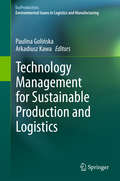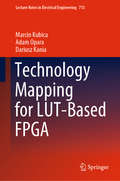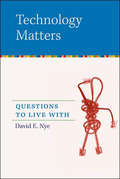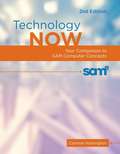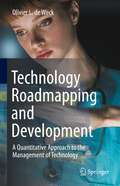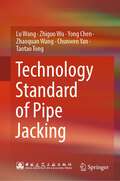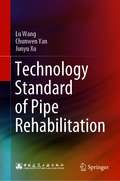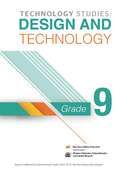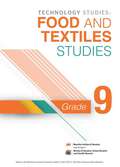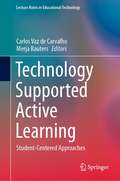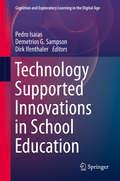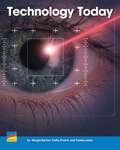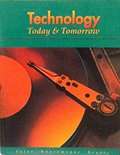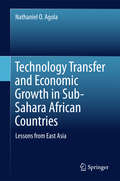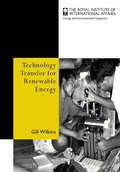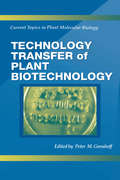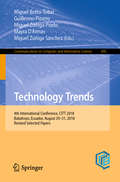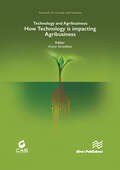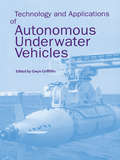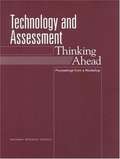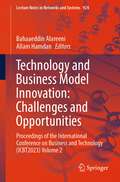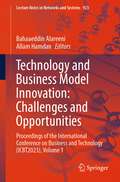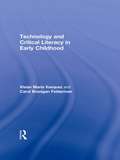- Table View
- List View
Technology Management for Sustainable Production and Logistics
by Paulina Golińska Arkadiusz KawaInnovative technologies provide opportunities for making manufacturing and logistics operations cleaner and more resource-efficient. New technologies focus on lifecycle engineering and lifecycle management. This book will be valuable to both academics and practitioners who wish to deepen their knowledge of technology management. The book will cover technical, organizational, financial and social issues connected to the implementation of more sustainable technologies.
Technology Mapping for LUT-Based FPGA (Lecture Notes in Electrical Engineering #713)
by Marcin Kubica Adam Opara Dariusz KaniaThis book covers selected topics of automated logic synthesis dedicated to FPGAs. The authors focused on two main problems: decomposition of the multioutput functions and technology mapping. Additionally, the idea of using binary decision diagrams (BDD) in these processes was presented. The book is a scientific monograph summarizing the authors’ many years of research. As a result, it contains a large number of experimental results, which makes it a valuable source for other researchers. The book has a significant didactic value. Its arrangement allows for a gradual transition from basic things (e.g., description of logic functions) to much more complex issues. This approach allows less advanced readers to better understand the described problems. In addition, the authors made sure that the issues described in the book were supported by practical examples, thanks to which the reader can independently analyze even the most complex problems described in the book.
Technology Matters: Questions to Live With
by David E. NyeTechnology matters, writes David Nye, because it is inseparable from being human. We have used tools for more than 100,000 years, and their central purpose has not always been to provide necessities. People excel at using old tools to solve new problems and at inventing new tools for more elegant solutions to old tasks. Perhaps this is because we are intimate with devices and machines from an early age--as children, we play with technological toys: trucks, cars, stoves, telephones, model railroads, Playstations. Through these machines we imagine ourselves into a creative relationship with the world. As adults, we retain this technological playfulness with gadgets and appliances--Blackberries, cell phones, GPS navigation systems in our cars. We use technology to shape our world, yet we think little about the choices we are making. In "Technology Matters," Nye tackles ten central questions about our relationship to technology, integrating a half-century of ideas about technology into ten cogent and concise chapters, with wide-ranging historical examples from many societies. He asks: Can we define technology? Does technology shape us, or do we shape it? Is technology inevitable or unpredictable? (Why do experts often fail to get it right?) How do historians understand it? Are we using modern technology to create cultural uniformity, or diversity? To create abundance, or an ecological crisis? To destroy jobs or create new opportunities? Should "the market" choose our technologies? Do advanced technologies make us more secure, or escalate dangers? Does ubiquitous technology expand our mental horizons, or encapsulate us in artifice? These large questions may have no final answers yet, but weneed to wrestle with them--to live them, so that we may, as Rilke puts it, "live along some distant day into the answers."
Technology Matters: Questions to Live With (The\mit Press Ser.)
by David E. NyeDiscusses in nontechnical language ten central questions about technology that illuminate what technology is and why it matters.Technology matters, writes David Nye, because it is inseparable from being human. We have used tools for more than 100,000 years, and their central purpose has not always been to provide necessities. People excel at using old tools to solve new problems and at inventing new tools for more elegant solutions to old tasks. Perhaps this is because we are intimate with devices and machines from an early age—as children, we play with technological toys: trucks, cars, stoves, telephones, model railroads, Playstations. Through these machines we imagine ourselves into a creative relationship with the world. As adults, we retain this technological playfulness with gadgets and appliances—Blackberries, cell phones, GPS navigation systems in our cars.We use technology to shape our world, yet we think little about the choices we are making. In Technology Matters, Nye tackles ten central questions about our relationship to technology, integrating a half-century of ideas about technology into ten cogent and concise chapters, with wide-ranging historical examples from many societies. He asks: Can we define technology? Does technology shape us, or do we shape it? Is technology inevitable or unpredictable? (Why do experts often fail to get it right?)? How do historians understand it? Are we using modern technology to create cultural uniformity, or diversity? To create abundance, or an ecological crisis? To destroy jobs or create new opportunities? Should "the market" choose our technologies? Do advanced technologies make us more secure, or escalate dangers? Does ubiquitous technology expand our mental horizons, or encapsulate us in artifice?These large questions may have no final answers yet, but we need to wrestle with them—to live them, so that we may, as Rilke puts it, "live along some distant day into the answers."
Technology Now: Your Companion to SAM Computer Concepts
by Corinne HoisingtonUpdated with the latest changes in technology as well as IC3 objectives, content aligns with new Computer Concepts tasks in SAM (Skills Assessment Manager), Cengage Learning's robust training and assessment system. Use the printed book with SAM or as a full digital solution in SAM or MindTap online for a learning experience ideal for all learning styles or levels of experience. Reading activities integrated with SAM Concepts training videos, SAM Exams and quizzing are delivered in a customizable learning path. This edition provides hands-on and critical-thinking activities, ethical scenarios, and team projects to elevate thinking and keep students engaged. Simple language, everyday examples, and visual information in small chunks further ensure understanding. Customize the printed book and SAM or MindTap to include only chapters that meet your objectives.
Technology Roadmapping and Development: A Quantitative Approach to the Management of Technology
by Olivier L. De WeckThis textbook explains Technology Roadmapping, in both its development and practice, and illustrates the underlying theory of, and empirical evidence for, technologic evolution over time afforded by this strategy. The book contains a rich set of examples and practical exercises from a wide array of domains in applied science and engineering such as transportation, energy, communications, and medicine. Professor de Weck gives a complete review of the principles, methods, and tools of technology management for organizations and technologically-enabled systems, including technology scouting, roadmapping, strategic planning, R&D project execution, intellectual property management, knowledge management, partnering and acquisition, technology transfer, innovation management, and financial technology valuation. Special topics also covered include Moore’s law, S-curves, the singularity and fundamental limits to technology. Ideal for university courses in engineering, management, and business programs, as well as self-study or online learning for professionals in a range of industries, readers of this book will learn how to develop and deploy comprehensive technology roadmaps and R&D portfolios on diverse topics of their choice.
Technology Standard of Pipe Jacking
by Yong Chen Lu Wang Chunwen Yan Zhiguo Wu Zhaoquan Wang Taotao TongThis book summarizes the technical method and construction process of pipe jacking. It has a total of 17 chapters and one appendix. It includes how to prepare the pipe jacking construction, how to choose the pipe and equipment for jacking, how to choose the engineering environment, how to do the geological survey before jacking, how to design the working pit, what's the procedure of pipe jacking, how to do the measurement and monitoring during jacking, how to do the treatment and acceptance after jacking, and so on. Appendix contains reference tables for pipe jacking archives, which might aid readers in understanding the book's content. This book's language is simple to read, and it has a wealth of graphics. Even those without a foundational understanding of pipe jacking could read and comprehend it with ease. This regulation could be the fundamental discipline for pipeline jacking projects. It is the important basis and criterion for the design, construction, management, inspection, and acceptance of pipeline jacking.
Technology Standard of Pipe Rehabilitation
by Lu Wang Chunwen Yan Junyu XuThis book summarizes the technical method and construction process of underground pipeline testing, cleaning, updating and repairing. It has 20 chapters and an appendix in total. Its content includes: Pipeline rehabilitation construction organization design, Pipeline cleaning, Preparations before construction, Pipeline detection and quality assessment, Pipeline rehabilitation design/method/equipment selection/steps/technical indicators, Pipe Cracking & Bursting method, Sliplining method, Pipe Segments Method, Lining with Inserted hose(improved) method, Cured in place pipe(CIPP), Spray lining, Spiral winding method, Spot repair method, universal construction techniques, construction of general rules, the engineering quality acceptance, construction health, safety, environmental protection and production management, and so on. The appendix is the interpretation for the relevant technical terms in this book. It could help the reader who doesn’t have the basic knowledge about pipe rehabilitation to understand this technology easily. This regulation could be the fundamental discipline for pipeline renewal projects in different industries. It could provide the important basis and criterion for design, construction, management, inspection and acceptance of pipeline renewal projects.
Technology Studies: Design And Technology class 9 - MIE
by Mauritius Institute of EducationDesigned for Grade 9 students following the National Curriculum Framework for Nine-Year Continuous Basic Education, this textbook delves into the realm of Design and Technology. Covering various topics such as Green Design, Pictorial Projection, and Material Technology, its primary focus is to cultivate students’ understanding of design concepts, technological appreciation, and practical skills in bringing designs to life. Structured with clear learning objectives, engaging activities, and hands-on projects, the textbook adopts an incremental approach to learning, ensuring students grasp concepts progressively and can apply them effectively. Through this pedagogical framework, students are encouraged to explore the intersection of creativity and technology, fostering a deeper appreciation for the role of design in shaping the world around them.
Technology Studies: Food And Textiles Studies class 9 - MIE
by Mauritius Institute of EducationAligned with Mauritius' National Curriculum Framework for Grades 7, 8, + 9, this textbook is a cornerstone of the Nine-Year Continuous Basic Education initiative. It prioritizes the development of cognitive skills through contextualized materials, ensuring engagement without compromising educational quality. Structured into units spanning topics like Nutrition and Health, Food Technology, and Textiles, the content is tailored for Grade 9 students, with clear learning objectives and activities. Beyond theoretical knowledge, practical application is emphasized through projects and activities, equipping learners with essential skills for real-life challenges. By fostering critical thinking, creativity, and responsible teamwork, this textbook not only educates but also empowers students to navigate and contribute to the complexities of the modern world.
Technology Supported Active Learning: Student-Centered Approaches (Lecture Notes in Educational Technology)
by Carlos Vaz de Carvalho Merja BautersThis book promotes student-centered approaches to the learning process, allowing students to develop skills and competences that traditional, passive learning methods cannot foster. In turn, supporting active learning with digital technology tools creates new possibilities in terms of pedagogical design and implementation. This book addresses the latest research and practice in the use of technology to promote active learning. As such, on the one hand, it focuses on active pedagogical methodologies like problem-based learning, design thinking and agile approaches; on the other, it presents best practice cases on the use of digital environments to support these methodologies. Readers will come to understand and learn to apply active learning methodologies, either by replicating the best practices presented here, or by creating their own methods.
Technology Supported Innovations in School Education (Cognition and Exploratory Learning in the Digital Age)
by Dirk Ifenthaler Pedro Isaias Demetrios G. SampsonThis volume provides a comprehensive and contemporary depiction of the swift evolution of learning technologies and the innovations that derive from their deployment in school education. It comprises cases studies, research focused on emergent technologies and experiments with existing tools in a wide range of scenarios. The studies included in this volume explore the conceptual and practical aspects of technologies that are used to support learning, with a multidisciplinary approach that encompasses all levels of education. The three sections of this volume emphasise the use of digital technologies from the viewpoint of different fields of expertise, explore multiple educational settings where technology was implemented to support the various stages of the learning process, and underline strategies, tools and technologies that play a crucial role in the professional development of teachers.
Technology Today
by Tammy Jones Margie Burton Cathy FrenchThis book is about the benefits of modern technology.
Technology Today & Tomorrow (3rd Edition)
by James F. Fales Vincent F. Kuetemeyer Sharon BrusicTeaches you about the numerous advances being made in the different areas of technology.
Technology Transfer and Economic Growth in Sub-Sahara African Countries
by Nathaniel O. AgolaThis book provides a pragmatic analytical model grounded on the solid idea that technologies and the accompanying implementation efforts only make sense if they are successfully deployed in markets. The analytical model also provides an exhaustive analysis of all critical variables at the global, regional and national levels, which contribute to failure or success of technology transfer efforts. The model is validated by an incisive analysis of technology transfer experiences of Japan, Korea, Singapore, Taiwan (province of China), and Malaysia. While this book finds that these East Asian countries have had both diverging and converging models, and experiences with technology transfer, the enduring and fundamental aspects of technology transfer in specific industrial sectors and economic growth in these countries is then used to draw lessons for African countries. This book therefore is a timely and compelling piece of research work that provides valuable answers to the increasingly urgent question of how African countries can industrialize through technology transfer to meet their economic development and growth ideals.
Technology Transfer for Renewable Energy
by Gill WilkinsThis text highlights the role that renewable energy can play in achieving sustainable development. It focuses on rural areas of developing countries, looking in particular at stand-alone solar home systems and grid-connected biomass cogeneration plants. It analyzes the main barriers to the successful transfer of renewable energy technology, with case studies from a range of South-East Asian, South Asian, Pacific and African countries, and explains the ways in which these obstacles can be overcome. The roles of the key players involved and how the Kyoto Protocol can facilitate the transfer in order to mitigate climate change are also discussed.
Technology Transfer of Plant Biotechnology (Current Topics In Plant Molecular Biology Ser. #3)
by Peter M. GresshoffPlant biotechnology has come of age. Products obtained by genetically engineered methods, once limited to science fiction, have become a reality. This book is an outstanding synthesis of the current status of technology transfer from the laboratory to the marketplace. It discusses the use of genetically engineered crops, with the focus on biotechnology becoming commercially marketable. Technology Transfer of Plant Biotechnology addresses these important new products.
Technology Trends: Third International Conference, Citt 2017, Babahoyo, Ecuador, November 8-10, 2017, Proceedings (Communications in Computer and Information Science #798)
by Miguel Botto-Tobar Guillermo Pizarro Miguel Zúñiga-Prieto Mayra D’Armas Miguel Zúñiga SánchezThis book constitutes the refereed proceedings of the 4th International Conference on Technology Trends, CITT 2018, held in Babahoyo, Ecuador, in August 2018. <P><P> The 53 revised full papers presented were carefully reviewed and selected from 204 submissions. The papers are organized in topical sections on communications; security and privacy; computer and software engineering; computational intelligence; e-government and e-participation.
Technology and Agribusiness: How the Technology is Impacting the Agribusiness
by Yoshifumi Nishio Amara Amara Yen-Kuang ChenThe world population is growing, and it is expected that in 2050 there will be 9.7 billion inhabitants on the Earth. According to FAO (United Nations, Food and Agriculture Organization) we need to increase the productivity of agriculture by between 50% and 70% to be able to feed the world population in 2050. Other researchers think that reducing the wastage of food may be enough to handle the 2050 population.Several factors must be considered to ensure that humanity is able to feed the world’s population in 2050 and beyond.• Less arable land: As cities are growing, the space available for agriculture is shrinking.• Climate change: Dramatic impacts on agribusiness.• Role of agribusiness on GHG emissions.• Planetary boundaries and the role of agribusiness.• Availability of freshwater.• Soil degradation.The seasonal school presents and discusses the major problems that agribusiness is facing and the different technologies that can be applied to solve and improve such issues. Specific case studies are presented along with the technological solutions that have been applied to solve or minimize the impact.Agribusiness covers different topics such as arable farming, dairy farming, fruits, vegetables, meat, etc. Each of these domains has different needs that can be addressed through smart agriculture technologies such as circuits and systems. Also, these domains affect the sustainability of the planet as they impact at least 4 out of the 9 planetary boundaries.
Technology and Applications of Autonomous Underwater Vehicles
by Gwyn GriffithsThe oceans are a hostile environment, and gathering information on deep-sea life and the seabed is incredibly difficult. Autonomous underwater vehicles are robot submarines that are revolutionizing the way in which researchers and industry obtain data. Advances in technology have resulted in capable vehicles that have made new discoveries on how th
Technology and Assessment: Proceedings from a Workshop
by National Research CouncilA report on Technology and Assessment:Thinking Ahead
Technology and Business Model Innovation: Proceedings of the International Conference on Business and Technology (ICBT2023) Volume 2 (Lecture Notes in Networks and Systems #924)
by Allam Hamdan Bahaaeddin AlareeniThis book proceedings addresses a crucial gap in understanding the impact of technology on Business Model Innovation (BMI). It emphasizes the need for further research to explore the intricate relationship between technology and BMI, focusing on opportunities and challenges. By delving into how technology influences emerging business model innovations and enhances operational efficiency, the publication aims to advance knowledge. Inviting diverse research methods, it sheds light on various ideas within the technology and BMI realm. Tailored for students, scholars, professionals, and policymakers, this book contributes to the evolving field of BMI and technology.
Technology and Business Model Innovation: Proceedings of the International Conference on Business and Technology (ICBT2023), Volume 1 (Lecture Notes in Networks and Systems #923)
by Allam Hamdan Bahaaeddin AlareeniThis book proceedings addresses a crucial gap in understanding the impact of technology on Business Model Innovation (BMI). It emphasizes the need for further research to explore the intricate relationship between technology and BMI, focusing on opportunities and challenges. By delving into how technology influences emerging business model innovations and enhances operational efficiency, the publication aims to advance knowledge. Inviting diverse research methods, it sheds light on various ideas within the technology and BMI realm. Tailored for students, scholars, professionals, and policymakers, this book contributes to the evolving field of BMI and technology.
Technology and Critical Literacy in Early Childhood
by Vivian Maria Vasquez Carol Branigan Felderman Bryan WoodsNow in its second edition, this popular text explores classrooms where technology and critical literacies are woven into childhood curricula and teaching. Using real-world stories, it addresses what ICTs afford critical literacy with young children, and how new technologies can be positioned to engage in meaningful and authentic learning. Concise but comprehensive, the text provides strategies, theoretical frameworks, demonstrations of practice, and resources for teachers. Updated with discussions of media literacy and new pedagogical tools, the second edition features new classroom examples and experiences that highlight the ways in which critical literacy, technology and media literacy come together in everyday life in the early childhood classroom. The inviting examples model how to use the interests and inquiry questions of young learners as a springboard for creating a critical curriculum. Each chapter includes Reflection Points, pedagogical invitations, and Resource Boxes to imagine new possibilities of working with students in engaging and supportive ways. The inspiring stories, guidance, and tools this book make it a great resource for pre-service teachers and students in Early Childhood Education and Literacy Education, and primary teachers and educators.
Technology and Critical Literacy in Early Childhood
by Vivian Maria Vasquez Carol Branigan FeldermanWhat do new technologies and new forms of communication mean for young children growing up in the 21st century? How are they shaping the mindsets, identities and practices which impact their lives at home and at school? This book explores the intersection of technology and critical literacy, specifically addressing what ICTs afford critical literacy work with young children between ages three to eight. Inviting readers to enter classrooms where both technology and critical literacies are woven into childhood curricula and teaching, it brings together literacy, social studies, and science in critical and integrated ways. Real-world stories show the sights and sounds of children engaged with technology in the classroom and beyond. Concise but comprehensive, the text provides strategies, theoretical frameworks, demonstrations of practice, and resources for teachers. Pedagogical features in each chapter engage readers in making connections to their own teaching situations. NCATE standards for including technology as an essential part of teacher education programs are addressed. While acknowledging how individual children employ ICT, the focus is on how new technologies can be positioned in early childhood learning communities as tools for engaging in more meaningful, authentic, and interesting learning.
